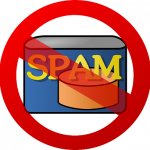Email is a great tool that allows us to keep in touch with friends and family, stay up to date with various newsletters, and even conduct business. But after a while, the ol’ inbox starts to fill up — and it can be overwhelming.
How do you stay on top of it all? How do you sort out the junk from the messages you actually want to read?
It may seem impossible, but the good news is there are ways to get on top of, and stay on top of, your email. The driving principle behind each of the tips below is simple: set up our inbox so we will never miss an email.
Re-thinking the Inbox
If you are like many people I’ve seen, you keep all of your messages in your inbox. It doesn’t matter if it’s old or new, read or unread — they’re all there. In my opinion, you should be trying to keep your inbox mostly empty. Yes, it’s possible, and it feels great having a clean inbox, knowing that you’ve responded to everything. So what if you have thousands of emails in your inbox? How do you get to that point?
Use Your Tools
Virtually all email services allow you to create Labels or Folders for your messages. If you aren’t already using these, now is the time to start! Create a few folders for your largest category of messages. At work, you might want to create one folder for each project. At home, you might want a folder for Online Purchases, and another for Family. My personal account has dozens of folders, which helps me stay organized. Quantity isn’t as important as the quality though — just make sure you create folders that make sense for you. If you have a high volume of messages, you may find that you want more categories. Start with a few basic categories, and then go from there if you feel that you need to be more specific. Fiddle with it until you are happy with it.
If you already have lots of messages in your inbox, you may want to spend some time looking through them to help you figure out which categories will help. Most email programs allow you to put multiple emails into a folder at once, so if you sit down once for 30 minutes or so, you should be able to get everything moved into folders. You’ll feel much better once you’ve done this!
Reduce Your Daily Emails
Seeing an inbox filled with countless emails can be depressing. It’s hard to start going through them because there are just too many! One way to reduce the number of emails you get is to filter out the messages that aren’t as important (e.g., online store ads that you signed up for). Over time, the number of newsletters and catalogs tends to grow, and it adds clutter to your inbox. I suggest periodically un-subscribing yourself from most of these — only keep the minimum number that you realistically have the time (or the inclination) to read through. I especially recommend getting rid of your daily subscriptions. Newsletters that come once a week or month won’t fill up your inbox as fast as the daily ones. Clicking the “Unsubscribe” link at the bottom of an email only takes a few moments, and it will reduce your inbox clutter (not to mention, it will reduce your temptation to buy more things that you probably don’t need). I know that I feel much better when the number of emails coming in each day feels manageable.
Spam is Bad for You

Say no to Spam
If you have a good spam filter, most junk mail should never even make it to your inbox. Most email services (such as Gmail) offer built-in spam filtering, and it’s generally pretty effective. If you find you are receiving junk messages in your inbox, take advantage of your email service’s method for reporting spam – there is usually a button with a title akin to “Mark as Spam” or “Send to Junk Mail”. This allows your filter to learn which emails to filter out in the future. By doing this a few times, the riffraff will be kept out, allowing you to focus on the important messages.
Give Yourself Some Rules
Now that your inbox is more organized, we want to create some rules that will help us make sure nothing slips through the cracks. There are essentially two types of emails: ones that need a response, and ones that don’t. Examples of emails that don’t need a response would be online catalogs, subscription updates, and most newsletters. Emails that do need a response would usually be a message from a friend or colleague. It’s important to note the difference, and you can even incorporate this idea into your folder arrangement if you want.
Here’s what I do:
- If I get interrupted and don’t finish reading an email, I mark it as unread and leave it in the inbox. That way I know I need to come back to it.
- After reading it, if I don’t need to respond, I will put it in the appropriate folder. I know it’s there if I ever want to refer back to it.
- If I do need to respond, I either respond right then (preferred method) or I mark it with a star (some programs use flags). This is how I know I need to respond later. If I know it will be some time before I am able to give a full response, I send a quick reply that says “I’m looking into it, I’ll get back to you soon.” Once I give a proper response, I move the message to the appropriate folder.
By always following these three simple rules, your inbox will stay clean, and you can say with confidence that you will never miss an email!






Recent Comments